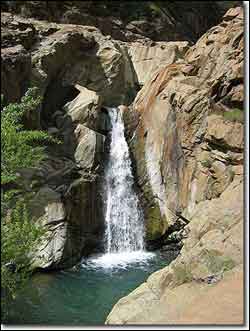New climate research reveals growing risk of water shortages and flooding in California

©2003 American River Conservancy <br>A waterfall on the North Fork of the American River, in the foothills of California’s eastern Sacramento Valley.
If the world continues to burn greenhouse gases, California may have an increased risk of winter floods and summer water shortages, even within the same year. This scenario may be more severe in future El Niño years.
New research by Lawrence Livermore National Laboratory (LLNL) scientists shows that global warming is likely to change river flows in ways that may result in both increased flood risk and water shortages. The predictions assume atmospheric carbon dioxide concentration doubles from preindustrial levels.
The amount of water flowing in California’s rivers needs to be just right. Too much brings a risk of flooding; too little causes reservoir levels to drop.
As temperatures warm as a result of carbon emission, more rain than snow falls at higher elevations. For the areas that do receive snow, melt occurs sooner.
The research shows that this well-known scenario – in which global warming causes an increase in wintertime river flows and a reduction in spring and summer flows – is more robust than previously thought.
“It seems unlikely that any changes in precipitation will be large enough to eliminate these problems,” said Philip Duffy, an LLNL physicist and director of the Institute for Research on Climate Change and its Societal Impacts, a University of California Intercampus Research Program. Furthermore, in an El Niño (a naturally occurring climate fluctuation) season, these problems may be more severe.
California’s water infrastructure is very efficient at providing an adequate water supply and minimizing flood risk. The system, however, works well only in a climate that includes large amounts of mountain snow. Melting snow keeps reservoirs full in the late spring and summer, after rain and snowfall have stopped. Snow acts as a natural reservoir, with a volume close to that of manmade reservoirs.
As global warming ensues, more precipitation will be in the form of rain rather than snow. Also, what snow remains will melt earlier in the year. These changes will result in higher river flow rates in California’s major rivers during winter and lower flows during spring and summer, when flows are largely from snowmelt.
“Even if total flows over the whole year are the same, these changes could jeopardize water supplies, because it may not be possible for reservoirs to capture the increased winter flows,” said Edwin Maurer, a professor at Santa Clara University and lead author of the research that appears in the Jan. 27 edition of the journal Geophysical Research Letters. “This problem would be compounded by an increased risk of wintertime flooding resulting from higher river flow rates,” he said.
This would force water managers to reduce reservoir water levels to provide extra space for capturing increased winter flood surges, which would further reduce the overall year’s water supply.
“In an El Niño year, which brings more rain than a typical year, there would be an increase (versus today) in the year-to-year variability in river flow rates, which would make life complicated for people who manage the water supply,” Duffy said.
The researchers simulated only monthly mean river flows, so they can’t quantitatively assess flood risk, which depends on daily-timescale river flows. However, the monthly flows are high enough to indicate that flood risk would be much higher.
“In particular, there will be increased wintertime river flows and lower spring and summer flows whether future precipitation increases or decreases modestly,” Maurer said. “It seems unlikely that the potential problems can be avoided by changes in precipitation.” This finding was published earlier this year by Maurer and Duffy.
The newest paper by Maurer, Duffy, and Seran Gibbard of LLNL’s AX Division investigates effects on California river flows of a hypothetical future-climate El NiÑo. El NiÑo is a naturally occurring climate oscillation that typically produces increased precipitation, river flows and flood risk in California.
The team’s work has some limitations: The researchers assumed that the strength of an El Niño, as measured by departures of sea-surface temperatures from long-term average values, will be the same in the future as today. They did this because climate models don’t agree on how the strength of an El Niño is likely to change.
Founded in 1952, Lawrence Livermore National Laboratory has a mission to ensure national security and to apply science and technology to the important issues of our time. Lawrence Livermore National Laboratory is managed by the University of California for the U.S. Department of Energy’s National Nuclear Security Administration.
Media Contact
More Information:
http://www.llnl.govAll latest news from the category: Earth Sciences
Earth Sciences (also referred to as Geosciences), which deals with basic issues surrounding our planet, plays a vital role in the area of energy and raw materials supply.
Earth Sciences comprises subjects such as geology, geography, geological informatics, paleontology, mineralogy, petrography, crystallography, geophysics, geodesy, glaciology, cartography, photogrammetry, meteorology and seismology, early-warning systems, earthquake research and polar research.
Newest articles

Silicon Carbide Innovation Alliance to drive industrial-scale semiconductor work
Known for its ability to withstand extreme environments and high voltages, silicon carbide (SiC) is a semiconducting material made up of silicon and carbon atoms arranged into crystals that is…

New SPECT/CT technique shows impressive biomarker identification
…offers increased access for prostate cancer patients. A novel SPECT/CT acquisition method can accurately detect radiopharmaceutical biodistribution in a convenient manner for prostate cancer patients, opening the door for more…

How 3D printers can give robots a soft touch
Soft skin coverings and touch sensors have emerged as a promising feature for robots that are both safer and more intuitive for human interaction, but they are expensive and difficult…




















